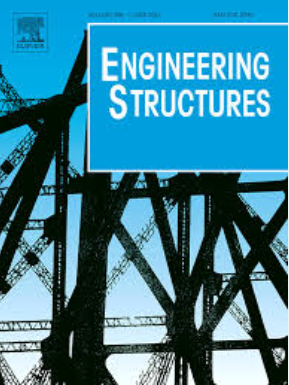Dynamic analysis and energy harvesting of double nonlinear stiffness vibration isolator
IF 6.4
1区 工程技术
Q1 ENGINEERING, CIVIL
引用次数: 0
Abstract
This paper proposes a double nonlinear stiffness vibration isolator (DNSVI) with gear-driven electromagnetic energy harvester (GEEH) for integration of vibration isolation and energy harvesting. DNSVI is composed of oblique spring structure and rhomboid structure both of which contribute to its nonlinear stiffness. Through a detailed investigation of the influence of structural parameters, the optimal quasi-zero stiffness condition can be achieved. The dynamic model has been developed, the force transmission rate is calculated by using the multi-scale method. The impacts of varying excitation amplitudes, damping and asymmetry on the force transmission rate are explored. More importantly, the GEEH is designed utilizing gear transmission mechanisms and electromagnetic energy harvesting technologies. The vibration isolation capabilities and energy harvesting efficiency of the DNSVI-GEEH are experimentally verified. The initial vibration isolation frequency is 3 Hz, and the peak power is 25 mW when the excitation frequency is 4.5 Hz, with an external 250 resistor. Thus, the DNSVI-GEEH offers a novel approach to achieving low-frequency vibration isolation and energy harvesting.
双非线性刚度隔振器的动力分析与能量收集
本文提出了一种双非线性刚度隔振器(DNSVI)与齿轮传动电磁能量采集器(GEEH)相结合的隔振和能量采集方法。DNSVI由斜弹簧结构和菱形结构组成,这两种结构都导致了它的非线性刚度。通过对结构参数影响的详细研究,得到了最优的准零刚度条件。建立了动力模型,采用多尺度法计算了力传递率。探讨了不同激励幅值、阻尼和不对称性对力传递率的影响。更重要的是,GEEH的设计利用齿轮传动机构和电磁能量收集技术。实验验证了DNSVI-GEEH的隔振能力和能量收集效率。初始隔振频率为3 Hz,外加250Ω电阻,激励频率为4.5 Hz时,峰值功率为25 mW。因此,DNSVI-GEEH提供了一种实现低频隔振和能量收集的新方法。
本文章由计算机程序翻译,如有差异,请以英文原文为准。
求助全文
约1分钟内获得全文
求助全文
来源期刊

Engineering Structures
工程技术-工程:土木
CiteScore
10.20
自引率
14.50%
发文量
1385
审稿时长
67 days
期刊介绍:
Engineering Structures provides a forum for a broad blend of scientific and technical papers to reflect the evolving needs of the structural engineering and structural mechanics communities. Particularly welcome are contributions dealing with applications of structural engineering and mechanics principles in all areas of technology. The journal aspires to a broad and integrated coverage of the effects of dynamic loadings and of the modelling techniques whereby the structural response to these loadings may be computed.
The scope of Engineering Structures encompasses, but is not restricted to, the following areas: infrastructure engineering; earthquake engineering; structure-fluid-soil interaction; wind engineering; fire engineering; blast engineering; structural reliability/stability; life assessment/integrity; structural health monitoring; multi-hazard engineering; structural dynamics; optimization; expert systems; experimental modelling; performance-based design; multiscale analysis; value engineering.
Topics of interest include: tall buildings; innovative structures; environmentally responsive structures; bridges; stadiums; commercial and public buildings; transmission towers; television and telecommunication masts; foldable structures; cooling towers; plates and shells; suspension structures; protective structures; smart structures; nuclear reactors; dams; pressure vessels; pipelines; tunnels.
Engineering Structures also publishes review articles, short communications and discussions, book reviews, and a diary on international events related to any aspect of structural engineering.
 求助内容:
求助内容: 应助结果提醒方式:
应助结果提醒方式:


